|
[Go to TOC]
Module 1 - Introduction to Matter, Energy, and Direct Current
Pages i,
1-1,
1-11,
1-21,
1-31,
1-41,
1-51,
1-61,
2-1,
2-11,
2-21,
3-1,
3-11,
3-21,
3-31,
3-41,
3-51,
3-61,
3-71,
3-81,
3-91,
3-101,
3-111,
3-121, Appendix
I,
II,
III,
IV,
V,
Index
An atom becomes a positive ion whenever it loses an electron, and has an overall
positive charge. Conversely, whenever an atom acquires an extra electron, it becomes
a negative ion and has a negative charge.
Due to normal molecular activity, there are always ions present in any material.
If the number positive ions and negative ions is equal, the material is electrically
neutral. When the number positive ions exceeds the number negative ions, the material
is positively charged. The material is negatively charged whenever the negative
ions outnumber the positive ions.
Since ions are actually atoms without their normal number electrons, it is the
excess or the lack electrons in a substance that determines its charge. In most
solids, the transfer charges is by movement electrons rather than ions. The transfer
charges by ions will become more significant when we consider electrical activity
in liquids and gases. At this time, we will discuss electrical behavior in terms
electron movement.
Q14. What is the electrical charge an atom which contains 8 protons and
11 electrons?
Charged Bodies
One the fundamental laws electricity is that LIKE CHARGES REPEL EACH OTHER and
UNLIKE CHARGES ATTRACT EACH OTHER. a positive charge and negative charge, being
unlike, tend to move toward each other. In the atom, the negative electrons are
drawn toward the positive protons in the nucleus. This attractive force is balanced
by the electron's centrifugal force caused by its rotation about the nucleus. As
a result, the electrons remain in orbit and are not drawn into the nucleus. Electrons
repel each other because their like negative charges, and protons repel each other
because their like positive charges.
The law charged bodies may be demonstrated by a simple experiment. Two pith (paper
pulp) balls are suspended near one another by threads, as shown in figure 1-6.
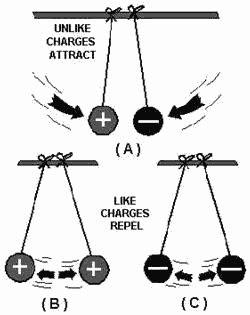
Figure 1-6. - Reaction between charged bodies.
If a hard rubber rod is rubbed with fur to give it a negative charge and is then
held against the right- hand ball in part (A), the rod will give f a negative charge
to the ball. The right-hand ball will have a negative charge with respect to the
left-hand ball. When released, the two balls will be drawn together, as shown in
figure 1-6(A). They will touch and remain in contact until the left-hand ball gains
a portion the negative charge the right-hand ball, at which time they will swing
apart as shown in figure 1-6(C). If a positive or a negative charge is placed on
both balls (fig. 1-6(B)), the balls will repel each other.
Coulomb's Law Charges
The relationship between attracting or repelling charged bodies was first discovered
and written about by a French scientist named Charles A. Coulomb. Coulomb's Law
states that CHARGED BODIES ATTRACT OR REPEL EACH OTHER WITH a forCE THAT Is DirectLY
PROPORTIONAL to The Product THEIR INDIVIDUAL CHARGES, and Is INVERSELY PROPORTIONAL
to The SQUARE The DIsTANCE BETWEEN THEM.
The amount attracting or repelling force which acts between two electrically
charged bodies in free space depends on two things - (1) their charges and (2) the
distance between them.
Electric Fields
The space between and around charged bodies in which their influence is felt
is called an ELECTRIC FIELD forCE. It can exist in air, glass, paper, or a vacuum.
ELECTROSTATIC FIELDS and Dielectric FIELDS are other names used to refer to this
region force.
Fields force spread out in the space surrounding their point origin and, in general,
DIMINIsH IN PROPORTION to The SQUARE The DIsTANCE FROM THEIR SOURCE.
The field about a charged body is generally represented by lines which are referred
to as ELECTROSTATIC Lines forCE. These lines are imaginary and are used merely to
represent the direction and strength the field. To avoid confusion, the lines force
exerted by a positive charge are always shown leaving the charge, and for a negative
charge they are shown entering. Figure 1-7 illustrates the use lines to represent
the field about charged bodies.
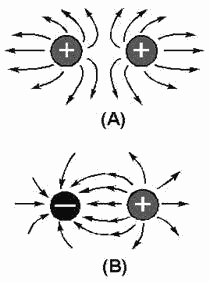
Figure 1-7. - Electrostatic lines force.
Figure 1-7(A) represents the repulsion like-charged bodies and their associated
fields. Part (B) represents the attraction unlike-charged bodies and their associated
fields.
Q15. What is the relationship between charged bodies? Q16.
What is an electrostatic field? Q17. In what direction are electrostatic
lines force drawn? MAGNETIsM
In order to properly understand the principles electricity, it is necessary to
study magnetism and the effects magnetism on electrical equipment. Magnetism and
electricity are so closely related that the study either subject would be incomplete
without at least a basic knowledge the other.
Much today's modern electrical and electronic equipment could not function without
magnetism. Modern computers, tape recorders, and video reproduction equipment use
magnetized tape. High-fidelity speakers use magnets to convert amplifier outputs
into audible sound. Electrical motors use magnets to convert electrical energy into
mechanical motion; generators use magnets to convert mechanical motion into electrical
energy.
Q18. What are some examples electrical equipment which use magnetism?
Magnetic MATERIALS
Magnetism is generally defined as that property a material which enables it to
attract pieces iron. a material possessing this property is known as a MAGNET. The
word originated with the ancient Greeks, who found stones possessing this characteristic.
Materials that are attracted by a magnet, such as iron, steel, nickel, and cobalt,
have the ability to become magnetized. These are called magnetic materials.
Materials, such as paper, wood, glass, or tin, which are not attracted by magnets,
are considered nonmagnetic. Nonmagnetic materials are not able to become magnetized.
Q19. What are magnetic materials?
Ferromagnetic Materials
The most important group materials connected with electricity and electronics
are the ferromagnetic materials. Ferromagnetic materials are those which are relatively
easy to magnetize, such as iron, steel, cobalt, and the alloys Alnico and Permalloy.
(An alloy is made from combining two or more elements, one which must be a metal).
These new alloys can be very strongly magnetized, and are capable obtaining a magnetic
strength great enough to lift 500 times their own weight.
Natural Magnets
Magnetic stones such as those found by the ancient Greeks are considered to be
NATURAL MAGNETS. These stones had the ability to attract small pieces iron in a
manner similar to the magnets which are common today. However, the magnetic properties
attributed to the stones were products nature and not the result the efforts man.
The Greeks called these substances magnetite.
The Chinese are said to have been aware some the effects magnetism as early as
2600 B.C. They observed that stones similar to magnetite, when freely suspended,
had a tendency to assume a nearly north and south direction. Because the directional
quality these stones, they were later referred to as lodestones or leading stones.
Natural magnets, which presently can be found in the United States, Norway, and
Sweden, no longer have any practical use, for it is now possible to easily produce
more powerful magnets.
Q20. What characteristics do all ferromagnetic materials have in common?
Artificial Magnets
Magnets produced from magnetic materials are called ARTIFICIAL MAGNETS. They
can be made in a variety shapes and sizes and are used extensively in electrical
apparatus. Artificial magnets are generally made from special iron or steel alloys
which are usually magnetized electrically. The material to be magnetized is inserted
into a coil insulated wire and a heavy flow electrons is passed through the wire.
Magnets can also be produced by stroking a magnetic material with magnetite or with
another artificial magnet. The forces causing magnetization are represented by magnetic
lines force, very similar in nature to electrostatic lines force.
Artificial magnets are usually classified as PERMANENT or TEMPORARY, depending
on their ability to retain their magnetic properties after the magnetizing force
has been removed. Magnets made from substances, such as hardened steel and certain
alloys which retain a great deal their magnetism, are called PERMANENT MAGNETS.
These materials are relatively difficult to magnetize because the opposition refered
to the magnetic lines force as the lines force try to distribute themselves throughout
the material. The opposition that a material refers to the magnetic lines force
is called RELUCTANCE. All permanent magnets are produced from materials having a
high reluctance.
A material with a low reluctance, such as st iron or annealed silicon steel,
is relatively easy to magnetize but will retain only a small part its magnetism
once the magnetizing force is removed. Materials this type that easily lose most
their magnetic strength are called TEMPORARY MAGNETS. The amount magnetism which
remains in a temporary magnet is referred to as its
RESIDUAL MAGNETIsM. The ability a material to retain an amount
residual magnetism is called the RETENTIVITY the material.
The difference between a permanent and a temporary magnet has been indicated
in terms RELUCTANCE, a permanent magnet having a high reluctance and a temporary
magnet having a low reluctance. Magnets are also described in terms the PERMEABILITY
their materials, or the ease with which magnetic lines force distribute themselves
throughout the material. a permanent magnet, which is produced from a material with
a high reluctance, has a low permeability. a temporary magnet, produced from a material
with a low reluctance, would have a high permeability.
Q21. What type magnetic material should be used to make a temporary magnet?
Q22. What is retentivity? Magnetic POLES
The magnetic force surrounding a magnet is not uniform. There exists a great
concentration force at each end the magnet and a very weak force at the center.
Pro this fact can be obtained by dipping a magnet into iron filings (fig. 1-8).
It is found that many filings will cling to the ends the magnet while very few adhere
to the center. The two ends, which are the regions concentrated lines force, are
called the POLES the magnet. Magnets have two magnetic poles and both poles have
equal magnetic strength.
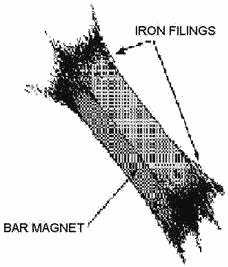
Figure 1-8. - Iron filings cling to the poles of a magnet.
Law of Magnetic Poles
If a bar magnet is suspended freely on a string, as shown in figure 1-9, it will
align itself in a north and south direction. When this experiment is repeated, it
is found that the same pole the magnet will always swing toward the north magnetic
pole the earth. Therefore, it is called the north-seeking pole or simply the NORTH
POLE. The other pole the magnet is the south-seeking pole or the SOUTH POLE.

Figure 1-9. - a bar magnet acts as a compass.
A practical use the directional characteristic the magnet is the compass, a device
in which a freely rotating magnetized needle indicator points toward the North Pole.
The realization that the poles a suspended magnet always move to a definite position
gives an indication that the opposite poles a magnet have opposite magnetic polarity.
The law previously stated regarding the attraction and repulsion charged bodies
may also be applied to magnetism if the pole is considered as a charge. The north
pole a magnet will always be attracted to the south pole another magnet and will
show a repulsion to a north pole. The law for magnetic poles is:
Like poles repel, unlike poles attract.
Q23. How does the law magnetic poles relate to the law electric charges?
The Earth's Magnetic Poles
The fact that a compass needle always aligns itself in a particular direction,
regardless its location on earth, indicates that the earth is a huge natural magnet.
The distribution the magnetic force about the earth is the same as that which might
be produced by a giant bar magnet running through the center the earth (fig. 1-10).
The magnetic axis the earth is located about 15° from its geographical axis
thereby locating the magnetic poles some distance from the geographical poles. The
ability the north pole the compass needle to point toward the north geographical
pole is due to the presence the magnetic pole nearby. This magnetic pole is named
the magnetic North Pole. However, in actuality, it must have the polarity a south
magnetic pole since it attracts the north pole a compass needle. The reason for
this conflict in terminology can be traced to the early users the compass. Knowing
little about magnetic effects, they called the end the compass needle that pointed
towards the north geographical pole, the north pole a compass. With our present
knowledge magnetism, we know the north pole a compass needle (a small bar magnet)
can be attracted only by an unlike magnetic pole, that is, a pole south magnetic
polarity.
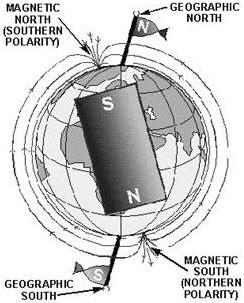
Figure 1-10. - The earth is a magnet.
Q24. a compass is located at the geographical North Pole. In which direction
would its needle pointy
THEORIES MAGNETIsM Weber's Theory
A popular theory magnetism considers the molecular alignment the material. This
is known as Weber's theory. This theory assumes that all magnetic substances are
composed tiny molecular magnets. Any unmagnetized material has the magnetic forces
its molecular magnets neutralized by adjacent molecular magnets, thereby eliminating
any magnetic effect. a magnetized material will have most its molecular magnets
lined up so that the north pole each molecule points in one direction, and the south
pole faces the opposite direction. a material with its molecules thus aligned will
then have one effective north pole, and one effective south pole. An illustration
Weber's Theory is shown in figure 1-11, where a steel bar is magnetized by stroking.
When a steel bar is stroked several times in the same direction by a magnet, the
magnetic force from the north pole the magnet causes the molecules to align themselves.
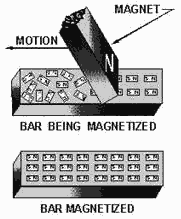
Figure 1-11. - Weber's molecular theory magnetism.
Q25. Using Weber's molecular theory magnetism, describe the polarity the
magnetic poles produced by stroking a magnetic material from right to left with
the south pole a magnet.
Domain Theory
A more modern theory magnetism is based on the electron spin principle. From
the study atomic structure it is known that all matter is composed vast quantities
atoms, each atom containing one or more orbital electrons. The electrons are considered
to orbit in various shells and subshells depending upon their distance from the
nucleus. The structure the atom has previously been compared to the solar system,
wherein the electrons orbiting the nucleus correspond to the planets orbiting the
sun. Along with its orbital motion about the sun, each planet also revolves on its
axis. It is believed that the electron also revolves on its axis as it orbits the
nucleus an atom.
It has been experimentally proven that an electron has a magnetic field about
it along with an electric field. The effectiveness the magnetic field an atom is
determined by the number electrons spinning in each direction. If an atom has equal
numbers electrons spinning in opposite directions, the magnetic fields surrounding
the electrons cancel one another, and the atom is unmagnetized. However, if more
electrons spin in one direction than another, the atom is magnetized. An atom with
an atomic number 26, such as iron, has 26 protons in the nucleus and 26 revolving
electrons orbiting its nucleus.
If 13 electrons are spinning in a clockwise direction and 13 electrons are spinning
in a counterclockwise direction, the opposing magnetic fields will be neutralized.
When more than 13 electrons spin in either direction, the atom is magnetized. An
example a magnetized atom iron is shown in figure 1-12.

Figure 1-12. - Iron atom.
Q26. What is the difference between the domain theory and Weber‘s theory
magnetism?
Magnetic FIELDS
The space surrounding a magnet where magnetic forces act is known as the magnetic
field.
A pattern this directional force can be obtained by performing an experiment
with iron filings. a piece glass is placed over a bar magnet and the iron filings
are then sprinkled on the surface the glass. The magnetizing force the magnet will
be felt through the glass and each iron filing becomes a temporary magnet. If the
glass is now tapped gently, the iron particles will align themselves with the magnetic
field surrounding the magnet just as the compass needle did previously. The filings
form a definite pattern, which is a visible representation the forces comprising
the magnetic field. Examination the arrangements iron filings in figure 1-13 will
indicate that the magnetic field is very strong at the poles and weakens as the
distance from the poles increases. It is also apparent that the magnetic field extends
from one pole to the other, constituting a loop about the magnet.

Figure 1-13. - Pattern formed by iron filings.
Q27. Refer to figure 1-13. For what purpose would you sprinkle iron filings
on the glass plate?
Q28. Refer to figure 1-13. What pattern would be formed if sawdust was
sprinkled on the glass instead iron filings?
Lines Force
To further describe and work with magnet phenomena, lines are used to represent
the force existing in the area surrounding a magnet (refer to fig. 1-14). These
lines, called Magnetic Lines forCE, do not actually exist but are imaginary lines used to illustrate and describe the pattern the magnetic field. The magnetic lines
force are assumed to emanate from the north pole a magnet, pass through surrounding
space, and enter the south pole. The lines force then travel inside the magnet from
the south pole to the north pole, thus completing a closed loop. 
Figure 1-14. - Bar magnet showing lines of force.
| - |
Matter, Energy,
and Direct Current |
| - |
Alternating Current and Transformers |
| - |
Circuit Protection, Control, and Measurement |
| - |
Electrical Conductors, Wiring Techniques,
and Schematic Reading |
| - |
Generators and Motors |
| - |
Electronic Emission, Tubes, and Power Supplies |
| - |
Solid-State Devices and Power Supplies |
| - |
Amplifiers |
| - |
Wave-Generation and Wave-Shaping Circuits |
| - |
Wave Propagation, Transmission Lines, and
Antennas |
| - |
Microwave Principles |
| - |
Modulation Principles |
| - |
Introduction to Number Systems and Logic Circuits |
| - |
- Introduction to Microelectronics |
| - |
Principles of Synchros, Servos, and Gyros |
| - |
Introduction to Test Equipment |
| - |
Radio-Frequency Communications Principles |
| - |
Radar Principles |
| - |
The Technician's Handbook, Master Glossary |
| - |
Test Methods and Practices |
| - |
Introduction to Digital Computers |
| - |
Magnetic Recording |
| - |
Introduction to Fiber Optics |
| Note: Navy Electricity and Electronics Training
Series (NEETS) content is U.S. Navy property in the public domain. |
|

















